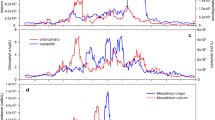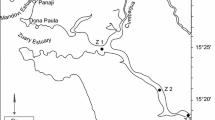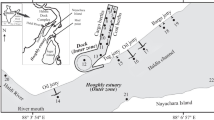Abstract
The response of phytoplankton to the presence of two mesozooplanktonic grazers was studied in a 44-h laboratory experiment from the phytoplankton perspective. The <45-μm-filtered plankton community, as well as females of the copepod Eurytemora affinis and nauplii of the barnacle Balanus improvisus originated from the northern Baltic Sea. The phytoplankton community was dominated by the dinoflagellate Heterocapsa triquetra, which was preferred as food by the mesozooplanktonic grazers, especially E. affinis. Cryptophytes were eaten by the B. improvisus nauplii, while heterotrophic nanoflagellates increased in the presence of B. improvisus nauplii, and colonial cyanobacteria increased in the presence of E. affinis. Because of the strong selective feeding on the dominant, large-sized phytoplankton species, the negative effect of the mesozooplanktonic grazers on total chlorophyll a was stronger than any cascade effect releasing phytoplankton from protozoan grazing.






Similar content being viewed by others
References
Anderson P (1994) Barnacles: structure, function development and evolution. Chapman & Hall, London, p 357
Ban S, Burns C, Castel J, Chaudron Y, Christou E, Escribano R, Umani SF, Gasparini S, Ruiz FG, Hoffmeyer M, Ianora A, Kang H-K, Laabir M, Lacoste A, Miralto A, Ning X, Poulet S, Rodriguez V, Runge J, Shi J, Starr M, Uye S, Wang Y (1997) The paradox of diatom-copepod interactions. Mar Ecol Prog Ser 157:287–293
Berggreen U, Hansen B, Kiørboe T (1988) Food size spectra, ingestion and growth of the copepod Acartia tonsa during development: implications for determination of copepod production. Mar Biol 99:341–352
Burns CW, Hegarty B (1994) Diet selection by copepods in the presence of cyanobacteria. J Plankton Res 16:1671–1690
Cowles TJ, Olson RJ, Chisholm SW (1988) Food selection by copepods: discrimination on the basis of food quality. Mar Biol 100:41–49
de Bernardi D, Giussani R (1990) Are blue-green algae a suitable food for zooplankton? An overview. Hydrobiol 200(201):29–41
DeMott WR (1986) The role of taste in food selection by freshwater zooplankton. Oecologia 69:334–340
DeMott WR, Zhang QC, Carmichael WW (1991) Effects of toxic cyanobacteria and purified toxins on the survival and feeding of a copepod and three species of Daphnia. Limnol Oceanogr 36:1346–1357
Engström J, Koski M, Viitasalo M, Reinikainen M, Repka S, Sivonen K (2000) Feeding interactions of the copepods Eurytemora affinis and Acartia bifilosa with the cyanobacteria Nodularia sp. J Plankton Res 22(7):1403–1409
Friedman MM, Strickler JR (1975) Chemoreception and feeding in calanoid copepods. Proc Natl Acad Sci USA 72:4185–4188
Fulton RS III, Paerl HW (1987) Effects of colonial morphology on zooplankton utilization of algal resources during blue-green algal (Microcystis aeruginosa) blooms. Limnol Oceanogr 32:634–644
Gasparini S, Castelt J (1997) Autotrophic and heterotrophic nanoplankton in the diet of the estuarine copepods Eurytemora affinis and Acartia bifilosa. J Plankton Res 19(7):877–890
Gerritsen J, Porter KG (1982) The role of surface chemistry in filter feeding by zooplankton. Science 216:1225–1227
Granéli E, Turner JT (2002) Top-down regulation in ctenophore-copepod-ciliate-diatom-phytoflagellate communities in coastal waters: a mesocosm study. Mar Ecol Prog Ser 239:57–68
Gulati RD, DeMott WR (1997) The role of food quality for zooplankton: remarks on the state-of-art, perspectives and priorities. Freshw Biol 38:753–768
Harris GP (1986) Phytoplankton ecology. Structure function and fluctuation. Cambridge University Press, Cambridge 384 p
Jónasdóttir SH (1994) Effects of food quality on the reproductive success of Acartia tonsa and Acartia hudsonica: laboratory observations. Mar Biol 121:67–81
Jónasdóttir SH, Kiørboe T (1996) Copepod recruitment and food composition: do diatoms affect hatching success? Mar Biol 125:743–750
Jónasdóttir SH, Kiørboe T, Tang KW, John M, Visser AW, Saiz E, Dam HG (1998) Role of diatoms in copepod production: good, harmless or toxic. Mar Ecol Prog Ser 172:305–308
Jonnson PR (1986) Particle size selection, feeding rates and growth dynamics of marine planktonic oligotrichous ciliates (Ciliophora, Oligotrichina). Mar Ecol Prog Ser 33:265–277
Kangro K, Olli K, Tamminen T, Lignell R (2007) Species-specific responses of a cyanobacteria dominated phytoplankton community to artificial nutrient limitation in the Baltic Sea. Mar Ecol Prog Ser 366:15–27
Katechakis A, Stibor H, Sommer U, Hansen T (2002) Changes in the phytoplankton community and in the microbial food web of Blanes Bay (Catalan Sea, NW-Mediterranean) under prolonged grazing pressure by doliolids (Tunicata), cladocerans or copepods (Crustaceae). Mar Ecol Prog Ser 234:55–69
Kivi K, Setälä O (1995) Simultaneous measurements of food particle selection and clearance rates of planktonic oligotrich ciliates (Ciliophora: Oligotricha). Mar Ecol Prog Ser 119:125–137
Kivi K, Kaitala S, Kuosa H, Kuparinen J, Leskinen E, Lingell R, Marcussen B, Tamminen T (1993) Nutrient limitation and grazing control of the Baltic plankton community during annual succession. Limnol Oceanogr 38(5):893–905
Kivi K, Kuosa H, Tanskanen S (1996) An experimental study on the role of crustacean and microprotozoan grazers in the planktonic food web. Mar Ecol Prog Ser 136:9–68
Kleppel GS (1993) On the diets of calanoid copepods (Review). Mar Ecol Prog Ser 99:183–195
Knisely K, Geller W (1986) Selective feeding of four zooplankton species on natural lake phytoplankton. Oecologia 69:86–94
Koroleff F, Grasshoff K (1983) Determination of nutrients. In: Grasshoff K (ed) Methods of seawater analysis. Verlag Chemie, Weinheim, pp 125–188
Koski M, Breteler WK, Schogt N (1998) Effect of food quality on rate of growth and development of the pelagic copepod Pseudocalanus elongatus (Copepoda, Calanoida). Mar Ecol Prog Ser 170:169–187
Koski M, Engström J, Viitasalo M (1999a) Reproduction and survival of the calanoid copepod Eurytemora affinis fed with toxic and non-toxic cyanobacteria. Mar Ecol Prog Ser 186:187–197
Koski M, Viitasalo M, Kuosa H (1999b) Seasonal development of mesozooplankton biomass and production on the SW coast of Finland. Ophelia 50:69–91
Kozlowsky-Suzuki B, Koski M, Hallberg E, Wallén R, Carlsson P (2009) Glutathione transferase activity and oocyte development in copepods exposed to toxic phytoplankton. Harmful Algae 8:395–406
Kuuppo P (1994) Annual variation in the abundance and size of heterotrophic nanoflagellates on the SW coast of Finland, the Baltic Sea. J Plankton Res 16:1525–1542
Kuuppo-Leinikki P (1990) Protozoan grazing on planktonic bacteria and its impact on bacterial population. Mar Ecol Prog Ser 63:227–238
Lehman JT (1988) Selective herbivory and its role in the evolution of phytoplankton growth strategies. In: Sandgren CD (ed) Growth and reproductive strategies of freshwater phytoplankton. Cambridge University Press, Cambridge, pp 369–388
Lehman JT, Sandgren CD (1985) Species specific rates of growth and grazing loss among freshwater algae. Limnol Oceanogr 30:34–46
Lignell R, Seppälä J, Kuuppo P, Tamminen T, Andersen T, Gismervik I (2003) Beyond bulk properties: Responses of coastal summer plankton communities to nutrient enrichment in the northern Baltic Sea. Limnol Oceanogr 48:189–209
Lindholm T, Nummelin C (1999) Red tide of the dinoflagellate Heterocapsa triquetra (Dinophyta) in a ferry-mixed coastal inlet. Hydrobiology 393:245–251
Moyse J, Knight-Jones EW (1967) Biology of Cirripede larvae. Proc Symp Crustac 2:595–611
Nasrolahi A, Sari A, Saifabadi S, Malek M (2007) Effects of algal diet on larval survival and growth of the barnacle Amphibalanus (=Balanus) improvisus. J Mar Biol Assoc UK 87:1227–1233
Nejstgaard JC, Gismervik I, Solberg PT (1997) Feeding and reproduction by Calanus finmarchicus, and microzooplankton grazing during mesocosm blooms of diatoms and the coccolithophore Emiliana huxley. Mar Ecol Prog Ser 147:197–217
Niemi Å (1975) Ecology of phytoplankton in the Tvärminne area, SW coast of Finland. II. Primary production and environmental conditions in the archipelago and the sea zone. Acta Bot Fenn 105:1–73
Olli K (2004) Temporary cysts formation of Heterocapsa triquetra (Dinophyceae) in natural populations. Mar Biol 145:1–8
Põllumäe A, Kotta J (2007) Factors describing the distribution of the zooplankton community in the Gulf of Finland in the context of interactions between native and introduced predatory cladoceranans. Oceanologia 49:277–290
Porter KG (1973) Selective grazing and differential digestion of algae by zooplankton. Nature 244:179–180
Redfield AC (1934) On the proportion of the organic derivatives in sea water and their relation to the composition of plankton. In: James Johnstone memorial volume. Liverpool University Press, Liverpool, pp 176-192
Reynolds CS (2006) Ecology of phytoplankton. Cambridge University Press, Cambridge 535 p
Schmidt K, Jónasdóttir SH (1997) Nutritional quality of two cyanobacteria: how rich is ‘poor’ food? Mar Ecol Prog Ser 151:1–10
Schnack SB (1982) The structure of the mouth parts of copepods in Kiel Bay. Meeresforschung Rep Mar Res 29:89–101
Sellner KG, Olson MM, Kononen K (1994) Copepod grazing in a summer cyanobacteria bloom in the Gulf of Finland. Hydrobiologia 292(293):249–254
Setälä O, Kivi K (2003) Planktonic ciliates in the Baltic Sea in summer: distribution, species association and estimated grazing impact. Aquat Microb Ecol 32:287–297
Setälä O, Sopanen S, Autio R, Erler K (2009) Grazing and food selection of the calanoid copepods Eurytemora affinis and Acartia bifilosa feeding on plankton assemblages containing Dinophysis spp. Bor Environ Res 14:837–849
Shurin JB, Borer ET, Seabloom EW, Anderson K, Blanchette CA, Broitman B, Cooper SD, Halpern BS (2002) A cross-ecosystem comparison of the strength of trophic cascades. Ecol Lett 5:785–791
Solorzano L, Sharp JH (1980) Determination of total dissolved phosphorus and particulate phosphorus in natural waters. Limnol Oceanogr 25:754–758
Sommer U (ed) (1989) Plankton ecology. Succession in Plankton communities. Springer, Berlin 369 p
Sommer U (2008) Trophic cascades in marine and freshwater Plankton. Internat Rev Hydrobiol 93:506–516
Sommer F, Stibor H, Sommer U, Velimoriv B (2000) Grazing by mesozooplankton from Kiel Bight, Baltic Sea, on different sized algae and natural seston size fractions. Mar Ecol Prog Ser 199:43–53
Sommer U, Hansen T, Stibor H, Vadstein O (2004) Persistence of phytoplankton responses to different Si:N ratios under mesozooplankton grazing pressure: a mesocosm study with NE Atlantic plankton. Mar Ecol Prog Ser 278:67–75
Sommer U, Hansen T, Blum O, Holzner N, Vadstein O, Stibor H (2005) Copepod and microzooplankton grazing in mesocosms fertilised with different Si:N ratios: no overlap between food spectra and Si:N influence on zooplankton trophic level. Oecologia 142:274–283
Sopanen S, Koski M, Kuuppo P, Uronen P, Legrand C, Tamminen T (2006) Toxic haptophyte Prymnesium parvum affects grazing, survival, egestion and egg production of calanoid copepods Eurytemora affinis and Acartia bifilosa. Mar Ecol Prog Ser 327:223–232
Sopanen S, Koski M, Uronen P, Kuuppo P, Lehtinen S, Legrand C, Tamminen T (2008) Prymnesium parvum exotoxins affect the grazing and viability of the calanoid copepod Eurytemora affinis. Mar Ecol Prog Ser 361:191–202
Sopanen S, Uronen P, Kuuppo P, Svensen C, Rühl A, Tamminen T, Granéli E, Legrand C (2009) Transfer of nodularin to the copepod Eurytemora affinis through the microbial food web. Aquat Microb Ecol 55:115–130
Sterner RW (1986) Herbivores’ direct and indirect effects on algal populations. Science 231:605–607
Sterner RW, Elser JJ (2002) Ecological stoichiometry. The biology of elements from molecules to the biosphere. Princeton University Press, Princeton 439 p
Stibor H, Vadstein O, Diehl S, Gelzleichter A, Hansen T, Hantzsche F, Katechakis A, Lippert B, Løseth K, Peters C, Roederer W, Sandow M, Sundt-Hansen L, Olsen Y (2004) Copepods act as a switch between alternative trophic cascades in marine pelagic food webs. Ecol Lett 7:321–328
Stoecker DK, Capuzzo DA (1990) Predation on protozoa: its importance to zooplankton. J Plankton Res 12:891–908
Tamminen T, Andersen T (2007) Seasonal phytoplankton nutrient limitation patterns as revealed by bioassays over Baltic Sea gradients of salinity and eutrophication. Mar Ecol Prog Ser 340:121–138
Teegarden GJ, Cembella AD (1996) Grazing of toxic dinoflagellates, Alexandrium spp., by adult copepods of coastal Maine: Implications for the fate of paralytic shellfish toxins in marine food webs. J Exp Mar Biol and Ecol 196:145–176
Teegarden GJ, Campbell RG, Durbin EG (2001) Zooplankton feeding behavior and particle selection in natural plankton assemblages containing toxic Alexandrium spp. Mar Ecol Prog Ser 218:216–226
Turner JT (1984) The feeding ecology of some zooplankters that are important prey items for larval fish. NOAA Tech Rep NMFS 7:1–28
Turner JT, Levinsen H, Nielsen TG, Hansen BW (2001) Zooplankton feeding ecology: grazing on phytoplankton and predation on protozoans by copepod and barnacle nauplii in Disko Bay, West Greenland. Mar Ecol Prog Ser 221:209–219
Uitto A (1996) Contribution of nanoprotist to metazooplankton diet in a mesocosm experiment in the coastal northern Baltic. J Plankton Res 18:2119–2137
Uitto A, Hällfors S (1997) Grazing by mesozooplankton and metazoan microplankton on nanophytoplankton in a mesocosm experiment in northern Baltic. J Plankton Res 19:655–673
Utermöhl H (1958) Zur Vervollkommnung der Quantitativen Phytoplankton-Methodik. Mitt Int Ver Theor Angew Limnol 9:1–38
Vargas CA, Cuevas LA, Gonzáles HE, Daneri G (2007) Bacterial growth response to copepod grazing in aquatic ecosystems. J Mar Biol Assoc UK 87:667–674
Viitasalo M (1992) Mesozooplankton of the Gulf of Finland and the northern Baltic proper—a review of monitoring data. Ophelia 35:147–168
Viitasalo M, Vuorinen I, Saesmaa S (1995) Mesozooplankton dynamics in the northern Baltic Sea: connections with hydrography and weather. J Plankton Res 17:1857–1878
Xu Z, Burns CW (1991) Development, growth and survivorship of juvenile calanoid copepods on diets of cyanobacteria and algae. Int Rev Gesamten Hydrobiol 75:73–87
Acknowledgments
This work was funded by the EU 6th Framework Project THRESHOLDS (GLOBAL/IP/02/0257), the Academy of Finland (S.L., grant 128987) and the Walter and Andrée de Nottbeck Foundation (S.S.). The work was done at the laboratory of Tvärminne Zoological Station, the University of Helsinki. We thank E. Salminen, M. Sjöblom and A. Nevalainen for analyzing the dissolved and particulate nutrient samples. We also thank the DHYBRIS project members for the cooperation during the mesocosm experiment.
Author information
Authors and Affiliations
Corresponding author
Additional information
Communicated by U. Sommer.
Rights and permissions
About this article
Cite this article
Lehtinen, S., Sopanen, S. & Tamminen, T. Community-level and species-specific responses of coastal phytoplankton to the presence of two mesozooplanktonic grazers. Mar Biol 157, 1555–1565 (2010). https://doi.org/10.1007/s00227-010-1429-1
Received:
Accepted:
Published:
Issue Date:
DOI: https://doi.org/10.1007/s00227-010-1429-1




